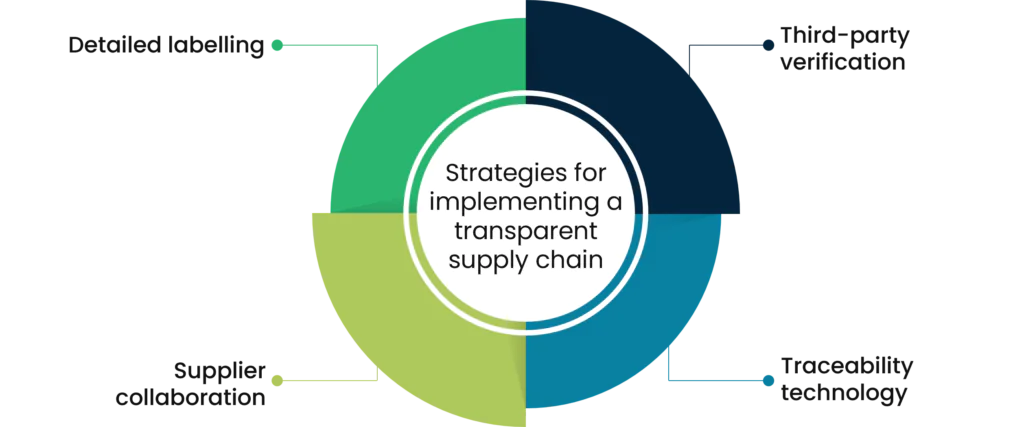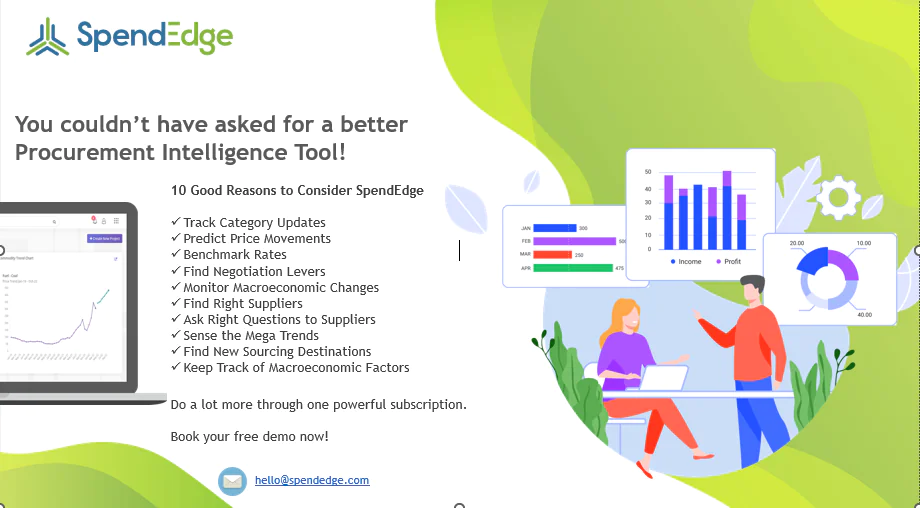Key takeaways
- Transparency and Trust: Transparency in the food and beverage industry is vital for cultivating trust, ensuring food safety, and meeting the growing consumer demand for organic and hygienic products.
- Technological Integration: Leveraging technologies like AI, blockchain, and digital solutions enhances supply chain visibility, efficiency, and resilience, helping manufacturers adapt to evolving customer demands.
- Local Sourcing and Sustainability: Nearshoring and circular supply chain investments reduce transportation costs and environmental impact, aligning with sustainability goals and improving response times to market changes.
- Modern Financial Strategies: Implementing modern finance solutions like supply chain financing helps manufacturers manage rising costs and maintain business continuity in a volatile economic landscape.
What is food and beverage supply chain?
The food and beverage supply chain is the sourcing, processing, and distribution of raw materials and ingredients to customers, involving various stakeholders such as farmers, processors, distributors, retailers, and consumers.
Why food & beverage businesses must become more transparent?
One industry that is constantly under the scanner to be more transparent and accountable is the food and beverage sector. Growing preference for organic food and increased focus on hygiene are the two main factors which keep the players in this industry on their toes. This brings forward the importance of transparency in the supply chain process, which companies in the food service aim to achieve. Transparency refers to the openness and clarity with which information, actions, and processes are communicated and made accessible to others, ensuring honesty, accountability, and the ability to make informed judgments. Transparency in F&B cultivates trust, informs choices, and enhances food safety. Open ingredient info empowers healthier selections, fostering loyalty while preventing allergen risks through clear communication.
Supply chains in food & beverage industry
Typically, a food & beverage supply chain starts from the farm in which the raw product is produced and ends with the final consumers. Freight carriers, forward warehouses, distribution centers, and 3PLs are other components in this rather long and interconnected chain of events. Undoubtedly, it is a challenge to see to it that all the stakeholders involved in this meet the demands of regulators and make their work process open to the public.
The inherent complexity and fragmented nature of supply chains call for a highly sharp and structured platform which makes the task of tracking the business flow easy to capture and simple to understand. Bringing all the stakeholders on the same page is yet another task that many players in the food service industry are trying to achieve.
Need to think beyond the traditional framework
For a transparent and seamless supply chain mechanism, it is essential that the right data be collected and put into use in the most intelligent manner possible. The traditional framework of data analysis is a rather restricted one, as it hardly goes beyond the peripheral analysis of operational data. Also, not being aligned with technology, it becomes rather difficult for traditional frameworks to quickly decipher large volumes of information. This gap in data processing makes it rather problematic to bring the element of transparency in the entire supply chain process, along with leaving minimal scope for innovation.
As industry experts, we believe that for any supply chain to be up-to-date and transparent, it is rather imperative that technology is aptly brought into play. It is in this context that data analytics, spend analysis and benchmarking need to work hand in hand. This way it becomes far easier to not only process huge volumes of data but also identify and predict potential problems which might evolve over a period of time.
A transparent supply chain is thus the result of optimal use of technology and converting the generated data into actionable strategies.
For a detailed understanding of spend analysis and supply chain management
Strategies for implementing a transparent supply chain

Detailed Labeling: Provide comprehensive ingredient lists, nutritional information, and sourcing details on packaging, ensuring consumers have clear insights into the product’s origin and components.
Supplier Collaboration: Forge partnerships with suppliers committed to ethical practices. Share information about sourcing, production processes, and quality standards to maintain transparency throughout the supply chain.
Traceability Technology: Implement digital solutions like blockchain to track and share real-time data about product movements, origins, and handling conditions, enabling consumers to verify the journey of their food and beverages.
Third-Party Verification: Engage independent organizations to audit and verify your supply chain practices. Certification and auditing provide an external validation of your transparency efforts, enhancing credibility with consumers.
Major challenges facing food and beverage manufacturers
Resource shortages
One of the main concerns for food and beverage manufacturers is the shortage of labor and raw materials. For example, Russia’s invasion of Ukraine, one of the world’s largest agricultural producers, has led to export shortages and volatile prices for resources like corn, wheat, and sunflower oil. These shortages result in higher costs and delays for food manufacturers, significantly impacting customer satisfaction and profit margins. Food and beverage supply chains are struggling to fill important roles, such as warehouse workers and drivers, leading to delayed deliveries.
Tight margins and steep costs
The bottom lines of food and beverage manufacturers are being affected by raw material and labor shortages, rising fuel prices, inflation, high interest rates, and the cost of in-demand supply chain technologies. These companies must find ways to reduce costs without compromising business continuity and efficiency. As demand for more affordable working capital solutions like supply chain financing (SCF) increases, manufacturers are also facing greater pressure to comply with International Financial Reporting Standards (IFRS). For instance, in the United States, the Financial Accounting Standards Board now requires companies to disclose the terms and size of their supply chain financing programs.
Evolving customer demands
Food and beverage manufacturers need to adapt quickly to changes in offerings and navigate more complex stock-keeping units (SKUs) and order management processes. In addition, companies aiming to remain globally competitive must develop growth strategies for the Asia-Pacific (APAC) market, which has more than doubled its agri-food imports from European countries in the last decade. To seize this opportunity, manufacturers must integrate APAC legislation and consumer trends into their supply chains.
Supply chain resilience
The challenges collectively indicate a continuous struggle to establish and sustain more resilient supply chains. Manufacturers are under pressure to remain agile and meet new customer demands while minimizing disruptions in the supply chain. The issue is worsened by ineffective communication between buyers and suppliers, as well as an increase in food fraud. Food fraud not only impacts customer satisfaction but also leads to costly recalls, resulting in billions of dollars in losses for the industry annually.
Supply chain trends: Food and beverage industry
Digitalisation
One of the top trends that is helping to address challenges in the food and beverage supply chain is digital transformation. Investing in digital technologies is one of the most effective ways for supply chains to become more efficient, support business growth, and improve margins. Artificial intelligence techniques, such as machine learning, are helping food and beverage supply chains leverage data to make more informed decisions. For instance, software powered by machine learning can analyze data collected along the supply chain to quickly identify bottlenecks, alternative supplier opportunities, and demand trends for improved inventory management. Supply chains can also use sensors to ensure that products adhere to food safety standards, while robotics facilitate more efficient manufacturing processes.
Local sourcing
Nearshoring is a supply chain strategy that involves moving manufacturing closer to a company’s markets. More and more companies are now producing food and beverage products near where they will be sold. This makes it easier to adjust or increase production in response to changes in demand. The strategy also results in faster delivery times and can reduce transportation emissions, which is a bonus for companies with social, environmental, and governance (ESG) targets. To fully benefit from nearshoring, many companies are combining the strategy with more efficient order fulfillment (often through digitalization), diversified transportation services, and direct-to-consumer, direct-to-store, and last-mile delivery solutions.
Circular supply chain investments
Food and beverage supply chains are rethinking how they handle waste. Companies are finding ways to reuse food and beverage products that would otherwise end up in landfills through circular supply chains. This approach is not only better for the planet, but it also generates alternative revenue streams, optimizes resources, supports ESG goals, and appeals to sustainability-minded customers.
Modern finance solutions
Food and beverage manufacturers are increasing their spending on financing due to rising inflation and interest rates. These factors have led to the growth of supply chain financing, which is a cost-effective way to optimize working capital without disrupting the supply chain. Simply put, supply chain finance involves partnering with a lender, such as a bank or fintech company, to provide early payments to suppliers. In the past, supply chain finance programs were inefficient and often inaccessible, especially for smaller suppliers. However, the industry is rapidly changing as fintech companies develop more efficient, flexible, and accessible approaches.

Conclusion
The food and beverage industry faces numerous challenges including raw material shortages, export shortages, and rising transportation, material, and labor costs. As customer demands evolve, manufacturers must adapt to complex supply chain processes while ensuring supply chain visibility and resilience. Embracing key trends like digitalization, local sourcing, and innovative supply chain technologies is crucial for addressing these challenges. Investment in digital purchasing options, same-day delivery capabilities, and cold-chain products, coupled with personalized experiences, can enhance efficiency and customer satisfaction. By leveraging technologies such as artificial intelligence and blockchain, manufacturers can improve logistics and supply chain visibility, enabling more informed decision-making. Adopting modern finance solutions and circular supply chain practices can also help manage costs and support sustainability goals. Ultimately, a transparent, technologically advanced supply chain will be essential for manufacturers to navigate the complexities of the modern food and beverage market and meet ever-changing customer demands.




